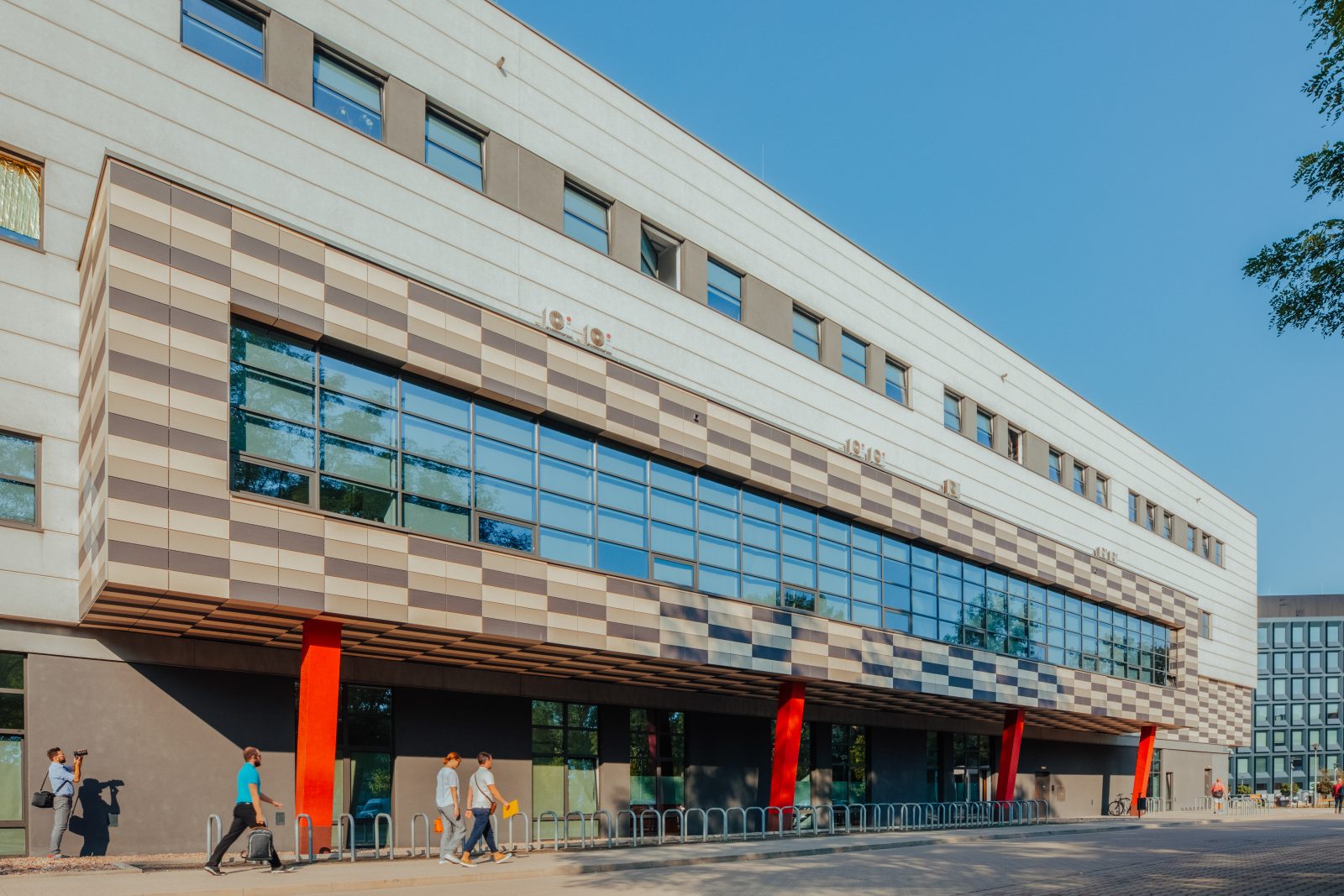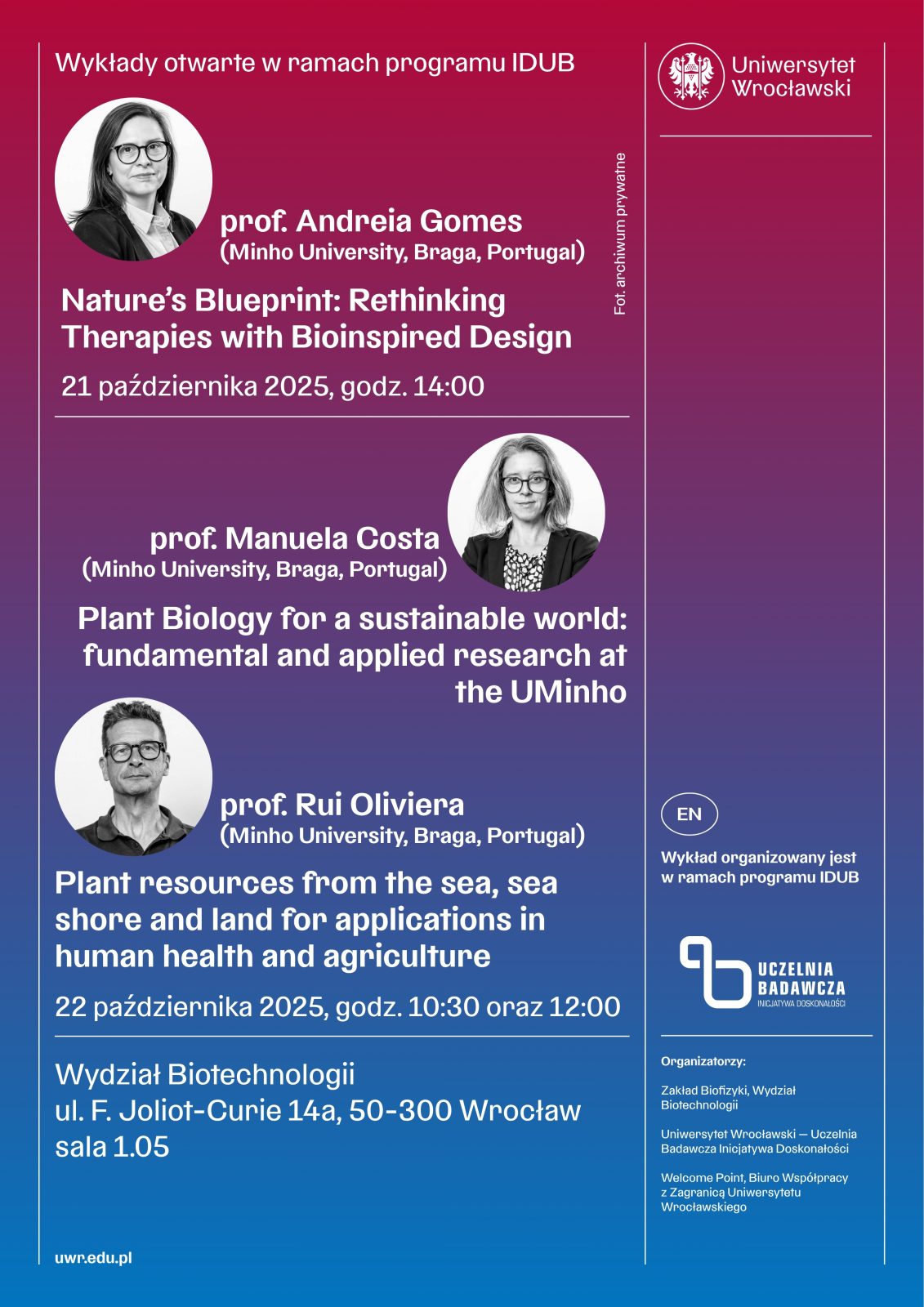
Scientists from Portugal visit the Faculty of Biotechnology of the University of Wrocław
The Faculty of Biotechnology of the University of Wrocław would like to invite you to a series of scientific lectures as part of the Visiting Professors programme. Distinguished scientists from the Centre of Molecular and Environmental Biology, Minho University, Braga, Portugal, will be our guests on October 21st and October 22nd, 2025.
The event will commence on Tuesday, October 21st, at 2 p.m., with Professor Andreia Gomes’s lecture titled: “Nature’s Blueprint: Rethinking Therapies with Bioinspired Design”.
On Wednesday, 22nd October, the following two lectures will take place: at 10:30 a.m. Manuela Costa will present her lecture “Plant Biology for a sustainable world: fundamental and applied research at the UMinho”. Later, at noon, Professor Rui Oliveira will present her topic “Plant resources from the sea, sea shore and land for applications in human health and agriculture”
All lectures will take place in room 1.03 of the Faculty of Biotechnology at ul. F. Joliot-Curie 14a.
Below, we present biographical notes and lecture summaries.
On 21st October at 2 p.m., a lecture titled “Nature’s Blueprint: Rethinking Therapies with Bioinspired Design” will be given by Professor Andreia Gomes.
Professor Andreia Gomes (ORCID 0000-0001-9032-5690, HI 31, 146 publications, over 3000 citations) is a biologist holding a PhD in Neurology (2004) from Karolinska Institutet, Sweden. Currently, she holds the position of an Associate Professor in the Department of Biology at the University of Minho in Portugal and an Associate Director of the Centre of Molecular and Environmental Biology (CBMA, https://cbma.uminho.pt, from 2022). Her current research interests focus on the development of bioinspired drug delivery systems, in particular on preliminary selection of bioactive compounds extracted from plants and other organisms (algae, sea sponges), as well as devising nanodevices with components produced by cell factories or procured through the process of green synthesis. Professor Gomes displays a particular focus on researching the reaction between nanostructures and cells and tissues (so-called bio-nano interface) in order to optimise therapeutic effect.
Projects led by Andrea Gomes imply the development of technologies/prototypes on a laboratory scale and cooperation with industry (such as FP7 Project Nanafol or Project ATLANTIDA). She is the co-founder of a spin-off that is concerned with the technology of controlled delivery of nucleic acids. Her portfolio contains patents concerning environmentally friendly packaging.
About the lecture
Living systems have evolved highly efficient mechanisms for molecular transport, communication, and repair — offering invaluable blueprints for the design of next-generation therapeutic platforms. Our current research focuses on the development of bioinspired drug delivery systems aimed at promoting human well-being. We engineer multifunctional bionanodevices built from natural or biomimetic components, and formulations mimicking natural mechanisms, providing targeted and sustainable strategies for therapeutic delivery. This talk will focus on a new nanocarrier inspired in naturally occurring exosomes for delivery of nucleic acids and bioactive components. Its main features will be presented as well as the development of neuroprotective tools with potential for management of neurodegenerative disorders, such as Alzheimer’s disease. In this talk, I will also present an overview of the research carried out by Translating Life – CBMA, at the University of Minho. Guided by the motto “Bio-resources and Bio-Inspired Systems towards Bio-Sustainability,” the group is committed to developing sustainable, biobased solutions for biotechnological and environmental challenges. Relying on CBMA’s biobanks and the CDB Microbial Research Resource Infrastructure (MIRRI-ERIC), Translating Life focuses on: (i) exploiting bioresources for greener solutions; (ii) promoting a circular bioeconomy through cell factories and precision fermentation; and (iii) improving environmental monitoring and remediation using bioinspired materials and devices.
On 22nd October at 10:30 a.m., a lecture titled “Plant Biology for a sustainable world: fundamental and applied research at the UMinho” will be given by Professor Manuela Costa.
Professor Manuela Costa defended her doctoral dissertation on molecular genetics at the John Innes Centres, Norfolk, Great Britain. She did a post-doc at the University of Edinburgh. Currently, she is employed at the University of Minho in Portugal as a biology professor.
The research of Professor Manuela Costa (ORCID 0000-0001-9032-5690, HI 19, 34 publications, over 1900 citations) is characterised by its sustainable development in a broad sense. She takes part in designing agronomic systems that enable the maximum levels of biodiversity. In particular, she focuses on understanding plants’ reactions to environmental conditions, including studying epigenetic changes, mechanisms of flowering regulation and signal transductions occuring within the plant cell. Additionally, she studies the genetics behind factors affecting plant resistance.
About the lecture
The development of floral structures is a pivotal step in the reproductive cycle of flowering plants and is controlled by endogenous and environmental cues fine-tuned by highly complex gene regulatory networks (GRNs). In our lab, we have been studying new MYB sub-family of transcriptional regulators called DIV-and-RAD-interacting-factors (DRIFs) first described in Antirrhinum majus, where they are involved in the antagonistic DDR module that regulates the establishment of flower asymmetry. InArabidopsis, AtDRIF mutant plants exhibited delayed flowering, and defects of growth under dark. Transcriptomic studies either in Antirrhinum majus,Arabidopsis, and Marchantia polymorpha have unveiled potential players into the physiological processes controlled by the DRIF genes. The knowledge of GRNs that control plant development, mostly obtained using model plants, has opened up the possibility of understanding likewise development programs in crops, which can be vital to improve important agronomic traits. In several Mediterranean countries, species from the Fagaceae family (e.g. Quercus suber, Castanea sativa) constitute the basis of an important agroforestry system. In our lab we are also studyingmolecular mechanisms that lead to a successful fructification in these trees, such as dormancy induction and break, flowering induction and development of unisexual male catkins and bisexual catkins. In this talk I will also give an overview, of the work we do in the group GROWING LIFE – CBMA at the University of Minho. In GROWING LIFE we are committed to explore agroecosystems resilience and disease control by exploring natural solutions, such as the use of biocontrol agents and non-chemical methods (https://cbma.uminho.pt/growing-life/).
On 22nd October at 10:30 a.m., a lecture titled “Plant resources from the sea, sea shore and land for applications in human health and agriculture” will be given by Professor Rui Oliveira.
Dr Rui Oliveira (ORCID 0000-0002-3989-8925, HI 17, 69 publications, over 1000 citations) is a specialist in relations between pathogens and flora, as well as in the usage of plant-based materials and substances (secondary metabolites) for medical and industrial (production of cosmetics and biotextiles) purposes. His achievements are, among others, studying antimicrobial activity of plant extracts, which includes explanation of its mechanisms, for example by defining the importance of the cell wall’s composition in protection, genotoxicity or induction of cell death mechanisms. He was engaged in a multitude of national and international projects, including a strategic project Fundao para a Cincia e a Tecnologia, which is concerned with environmental biology. Currently, he is engaged in the Ethnoherbs project, which is financed by an European Union agency. The goal of Ethnoherbs is the conduction of scrupulous ethnobotanic study connected alongside the usage of cutting-edge technology intended for procuring natural products, all in order to search for potential substances that are fit to be used therapeutically.
About the lecture
Being sessile organisms, plants have evolved sophisticated responses to cope with environmental stress. Their highly developed secondary metabolism accounts for the remarkable diversity of metabolites with relevant biological functions. Antioxidant activity, which protects genomes from oxidative damage, and antimicrobial activity, arising from adaptation to biotic stress, are among the most common features of these metabolites. It is therefore likely that plants thriving in extreme environments have evolved metabolic pathways that provide effective stress protection. Halophytes, which grow in seashore habitats, are particularly resilient to salinity and intense solar radiation. Similarly, algae are constantly exposed to high levels of sunlight. In this talk, I will present halophytes, macroalgae, and microalgae as representative sources of secondary metabolites with biological relevance. Halophytes are especially rich in polyphenols such as (+)-catechin, (−)-epicatechin, their oligomers, and myricetin derivatives, which have been associated with antigenotoxic effects. In contrast, algae predominantly synthesize pigments, lipids, and polysaccharides. The antioxidant and antigenotoxic properties of edible halophytes and microalgae extracts will be discussed, emphasizing their potential applications in functional foods designed to counteract environmental and dietary toxicants. For macroalgae, I will highlight their potential neuroprotective activity, underscoring the promise of marine organisms as a source of new pharmaceuticals. In addition, the antimicrobial activity of selected plant extracts will be shown as an alternative to synthetic fungicides in agriculture. Overall, the presentation will outline the potential of stress-resistant plants and algae as valuable sources of natural products, with promising applications in human health, nutrition, and sustainable agriculture.
Translated by Michał Zajączkowski (student of English Studies at the University of Wrocław) as part of the translation practice.

Date of publication: 7.10.2025
Added by: M.K.



